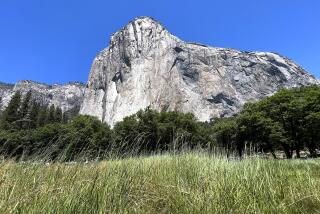Endangered National Parks Listed
- Share via
WASHINGTON — Some of the nation’s largest and most remote national parks face threats from pollution, neglect, overuse and efforts to increase access, an environmental group said Wednesday.
Releasing its third annual list of what it considers the 10 most-threatened parks, the National Parks Conservation Assn. complained that too much of President Bush’s proposed parks budget is directed toward “bricks and mortar” projects rather than preservation.
“His initial budget has very little new money for the parks,” said Thomas Kiernan, the group’s president.
The 82-year-old nonprofit organization wants $600 million added to Bush’s proposed parks budget of $4.9 billion to deal with problems threatening the nation’s 384 parks and historic sites.
“The air quality in our parks is getting worse,” said Kiernan. He also worries about introduction of animal and plant species that threaten existing wildlife and foliage in some parks.
An Interior Department spokesman said a response to the association’s report was being drafted.
Four parks the group identified last year as being among the most threatened are not on this year’s list:
* Joshua Tree National Park in California, where plans for a proposed landfill were suspended indefinitely.
* Underground Railroad Network to Freedom in the Eastern United States, for which the National Park Service has devoted $2.5 million in new allocations to preserve its facilities and documents.
* Ozark National Scenic River in Missouri, where nearby lead mining exploration has been suspended.
* Haleakala National Park in Hawaii, after plans were dropped to expand the airport on Maui, where the park is located.
These 10 park areas were listed this year as the most threatened:
* Alaskan parks--Denali, Katmai, Gates of the Arctic, Glacier Bay and Wrangell-St. Elias--all threatened by proposed development, underfunding and snowmobiles.
* Big Bend National Park in West Texas, threatened by air pollution and reduced water flow.
* Fire Island National Seashore on New York’s Atlantic Coast, where the association says a dune replenishment program has increased the potential for beach erosion.
* Frederick Douglass historic site in Washington, D.C., where collections of historical books, photographs and furnishings are deteriorating at the abolitionist’s home.
* Glacier National Park in Montana, troubled by development near the park’s boundaries, crumbling roads and other infrastructure problems.
* Great Smoky Mountains National Park in Tennessee and North Carolina, where pollution from Tennessee Valley Authority power plants threatens more than 30 species of plant life.
* Petrified Forest National Park in Arizona, where tourists remove 12 tons of petrified wood each year in violation of federal law.
* Everglades, Biscayne Bay and Big Cypress parks in southern Florida, where water levels and pollution continue to pose significant problems. All-terrain vehicles also are damaging Big Cypress.
* Yellowstone National Park in Wyoming and Montana, where the Bush administration is considering lifting a ban on snowmobiles.
More to Read
Sign up for Essential California
The most important California stories and recommendations in your inbox every morning.
You may occasionally receive promotional content from the Los Angeles Times.













